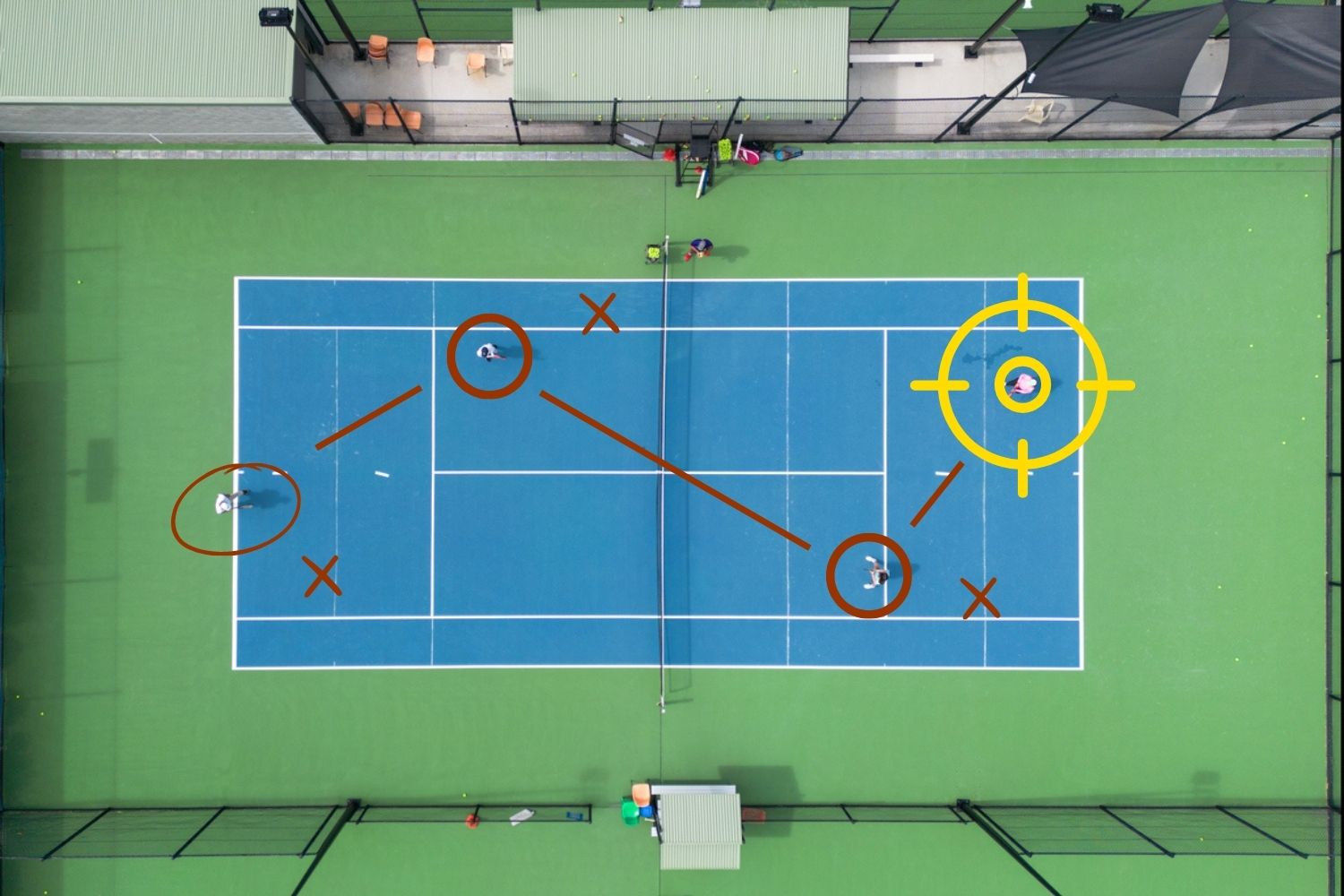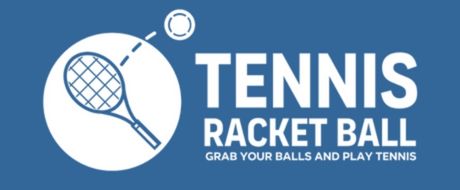Playing tennis in doubles is not the same experience as playing singles. It can be much more challenging and complex, as you’ll have to cover the full court’s size, focus more on volleys, and continuously communicate with your partner. That’s why it’s important to master the main doubles tennis strategy and tactics that will make your performance much better and the game more enjoyable.
In this guide, we covered everything you need to know on how to play doubles tennis, the main strategies, positions, and some helpful tricks that can help you and your partner to excel on the court and be the winning team. Keep scrolling!
10 Basic Tennis Doubles Strategies
All doubles players need to master these basic tennis doubles strategies in order to score more points and win matches. We made sure to break down all the information you need in full in-depth, and simplified explanations. Keep in mind that the order is random, and these tips are equally important.
#1 Position yourself correctly in the court.
You must position yourself in the right place of the court when you start your point. This is a common mistake amongst doubles beginner players, which puts them at a great disadvantage right from the start. When you are positioning yourself in a service position, ensure you are slightly inside the single lines, which is the perfect place for most situations.
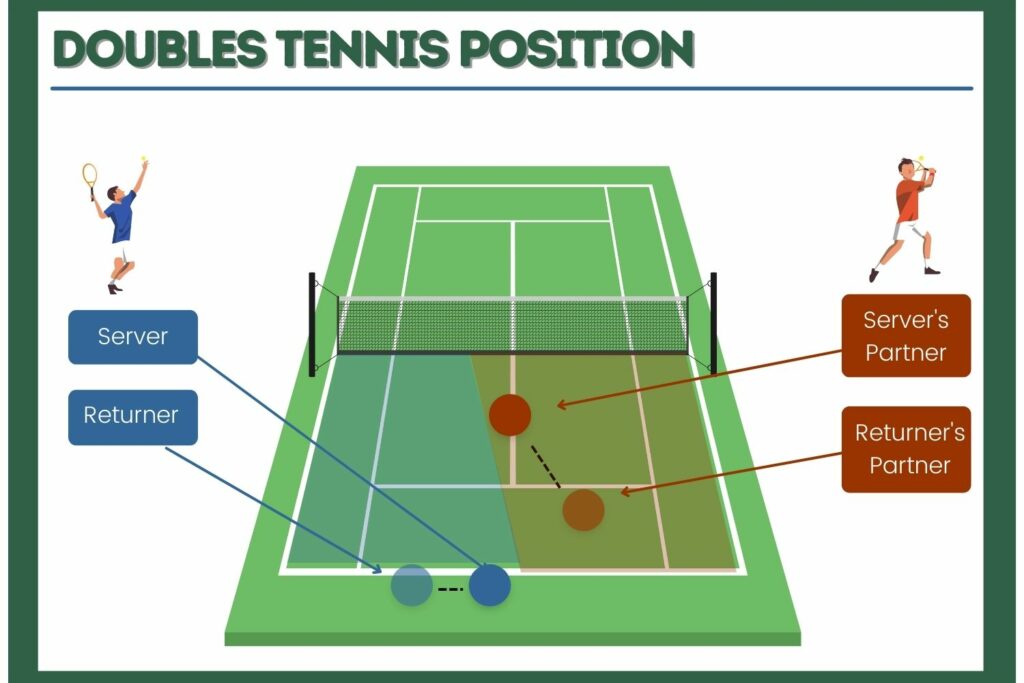
If you are used to playing singles, avoid the center when you would normally stand for a service because you will leave the sharp angle uncovered.
Standing too far out wide is also a big no because it would leave the middle court open. If you are the server’s partner, imagine a drawn big X on the service box (or literally draw it with chalk until you feel like you learn the right position) and stand right in the middle. Regarding returners, the best position is standing further back at the baseline, especially if you are dealing with a fast serve.
The returner partner should stand just in the cut of the service line. Tennis doubles position might make beginners feel like they are out of their comfort zone but hang in there because this is one of these cases where practice will make you perfect. You’ll put yourself in a winning position just by resuming the right position.
#2 Keep track of your opponents.
Just like in a single game, a double tennis player should focus on hitting all the targets with as much accuracy as possible. To ensure you won’t be shooting the ball aimlessly on the court and cost yourself some precious points, make sure that you and your partner are tracking your opponents.
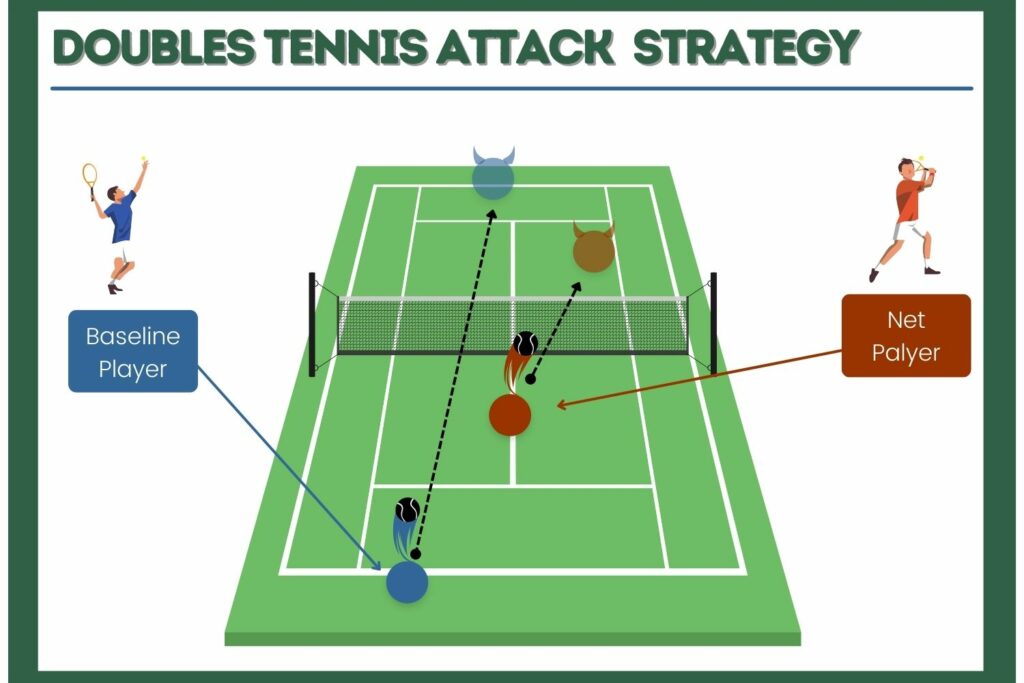
This strategy is very simple; all you have to do is to hit the ball towards the opponent standing in the same position as you. If you are positioned in the baseline, shoot towards the other baseliner; this way, you can prolong the point too, which is exactly what you want.
If you are in the net, your main job is to end the point, so to do that faster, aim for the opponent that is standing on the other side of the net.
This strategy is very effective and works 80% of the time. The only thing you have to do to make it work is to keep track of where your opponent is moving and hit the ball with accuracy. Simple, right?
#3 Move with the ball.
For every tennis player is important to learn how to move correctly even when you don’t have the ball. When you are playing doubles, you’ll have less time and opportunities to make your shots, as you are sharing the court with another partner too. This is not a time to rest though, and you can’t just stand in one place, waiting for your turn to make a hit.
Moving aimlessly on the court is not wise either because when the ball comes your way, most likely, you’ll be unprepared and underperform or even miss the shot.
A very simple yet effective strategy is acting like the ball is a magnet pulling you towards it. This strategy applies mostly to the volleyers, who are constantly switching between offense and defense positions.
It is very simple; when your partner in the baseline is shooting the ball behind you, go back to the end of the service box; when the ball is at the other baseliner, as we explained in the previous strategy, then go further, closer to the net.
This way, you’ll be covering your side of the court better, and it will give you more time to react if your opponent aims for fast exchanges to close the point. If the returner hits the ball near the server partner, poach the ball and aim for the opponent in the same position as you.
#4 React fast.
When the ball is behind you, pay attention to the net opponent! This will give you more time to react faster, and the attack will not come as a surprise, catching you off guard.
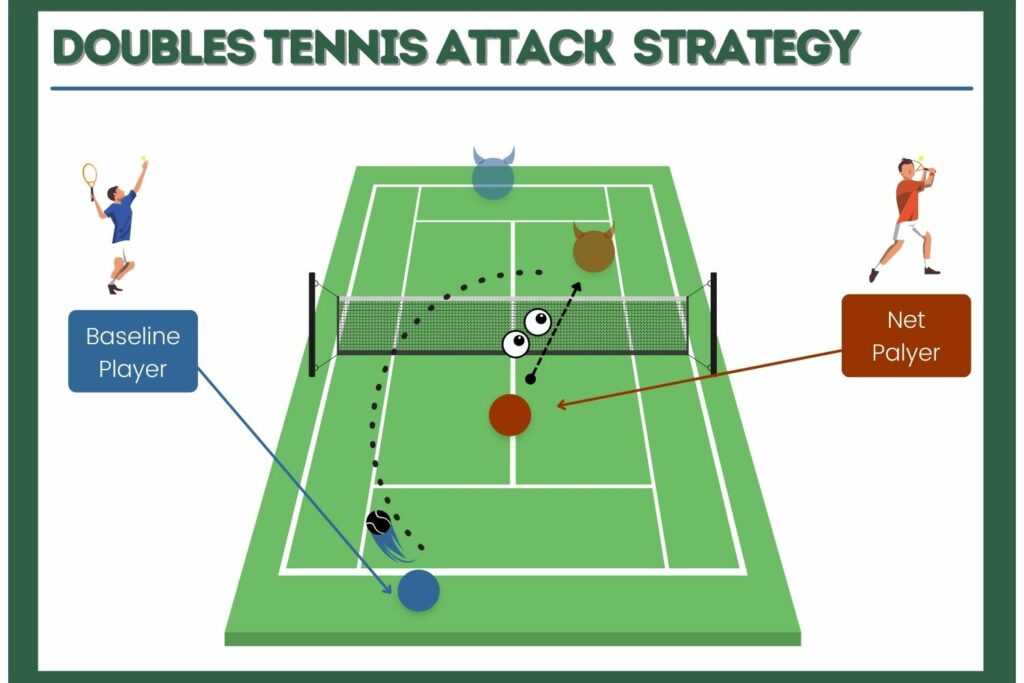
It’s okay if you look back at your partner in the baseline to see if they are lobbing, switching grip positions, or even struggling. But the moment you see your partner hit the ball, pay full attention to the opponent standing in the same position as you because that is the person that will mostly come for you throughout the game.
If your baseline partner accidentally hits the volleyer, just move further and keep your eyes on the opponent, to react fast because you are the target. This strategy falls in the same line as following the ball and keeping track of your opponent. Keep this into consideration, and it will help you perform better and with much more ease.
#5 Windshield wiper.
The windshield wiper strategy is more of a positioning scheme that will help you and your partner cover the entire court during the whole game. Most of the time, you’ll be covering only 50% of the court and your partner the other 50%, so neither of you leaves gaping loopholes for the opponent.
But considering the dynamic of tennis, this is not always the case. For example, if the opponent returns the ball way off the court after service, your partner will leave his part uncovered while going after the ball. Most likely, your partner won’t be able to return quickly enough to resume position after the hit.
As you are moving with the ball and keeping track of the opponent, make sure to move back and over. If your partner is way off the field yet, get in the middle of the court because, In all cases, the court should be 100% covered, even if you do it alone. Just like the windshield of a car, you should learn to move in harmony with your partner.
#6 Lob.
Lobbing requires more advanced skills and is one of the best doubles tennis strategies. If you or your partner go for a powerful lob, especially during the first serve, it will change the game pace. It will also create chaos on your opponent’s side, forcing them to switch positions, push back, and then rush to the net.
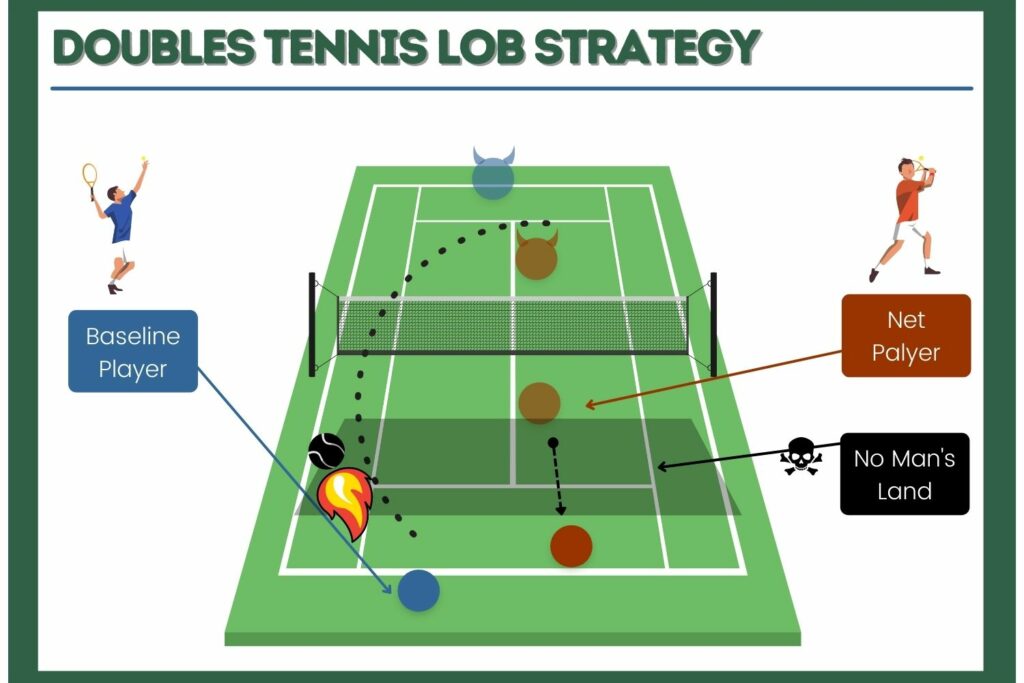
To take full advantage of a successful lob, both you and your partner should position yourselves in the service line to create an offensive wall. Most likely, the returner will hit an overhead shot in these cases, so you should slam the ball to the person close to the net, so you’ll have a better shot of closing the ball and keeping the advantage.
If you are the one getting lobbed, what you should do is move way back diagonally, in the “no man land” or even at the baseline with your partner, to create a better defense.
#7 Poach.
Poaching is an advanced and aggressive doubles tennis strategy that the player does position closer to the net. This happens when the baseliner is rallying, and you choose to move in the middle of the court and volley the ball up in the air.
Basically, you are forcing the opponent to make an error and close the point in your favor. To apply this strategy, you need constantly keep track of the opponent, and the ball’s direction, as explained above.
For a successful poach, you should;
- Poach on the low balls: so that your opponent has a harder time reacting or changing the ball direction for a quick net exchange.
- Master your skills: this is self-explanatory. You can’t poach unless you own the proper technique.
- Poach before a swing: especially if your partner serves big. It will frustrate your opponent, and more often than not, a poach in this scenario will catch them off guard.
- Poach after a swing: it will force them to change direction, which is a really difficult thing to do in a mid of a swing.
#8 Make the opponent struggle.
Aim for your opponent’s weakness or the weakest player. This might seem like a no-brainer, but you should not hesitate to do so if you want to win. For more advanced team players with an aggressive approach to the game, you can play both back and up.
This strategy will isolate the person closer to the net, who will be stuck in defense mode against two players at once, with less time to react.
Aiming for the volleyer’s feet has proven to be also successful when returning the shot. This will force your opponent to rush at the net, with less time to react while trying to reach for difficult angles.
#9 Pay attention to your opponent’s side.
This strategy is for more advanced players who have the skills and the experience to apply it. Pay attention to the side your opponent is moving the body to predict in which direction they will hit the ball so you can poach successfully.
Generally speaking, the ball travels the court like an X, and most players decide in which way to land the ball, depending on which side of the body they are moving at the moment of the shot, without even realizing what they are doing.
For example, if your opponent is most likely hitting the ball with their right side, it will be a cross-court shot on your left and vice-versa. By observing their movements, body pattern, and the ball’s spin and trajectory, you can accurately predict where your opponent will hit. But to achieve this, you probably need years of practice and a lot of patience.
#10 Talk with your partner.
In the short seconds between the points, make sure to communicate with your partner. This is something all the pro double players do, and for very good reasons. Talk about what serves are working the best against certain opponents, where you are going to aim for a return, a poach, or a lob.
What is going well with your game strategy, and what you both should be doing better. Just like in a football game, you need to huddle with your partner, this way, you’ll give each other more confidence and clarity. This simple 5-second talk can help you both perform better and win the game.
Tennis Doubles Positioning and Formation
We already mentioned that positions in the court are very important and will greatly impact your and your partner’s perfomance, as well as the outcome of the game. Here are the most popular tennis double formations and where to position yourselves.
The Australian Formation
The Australian formation is for very advanced and professional double players that have an aggressive approach to the game. To apply this formation, you and your partner should position yourselves on the same side of the court, on the same side as the server. By doing so, your opponent will be forced to hit down the lines for the returns, which is difficult to do.
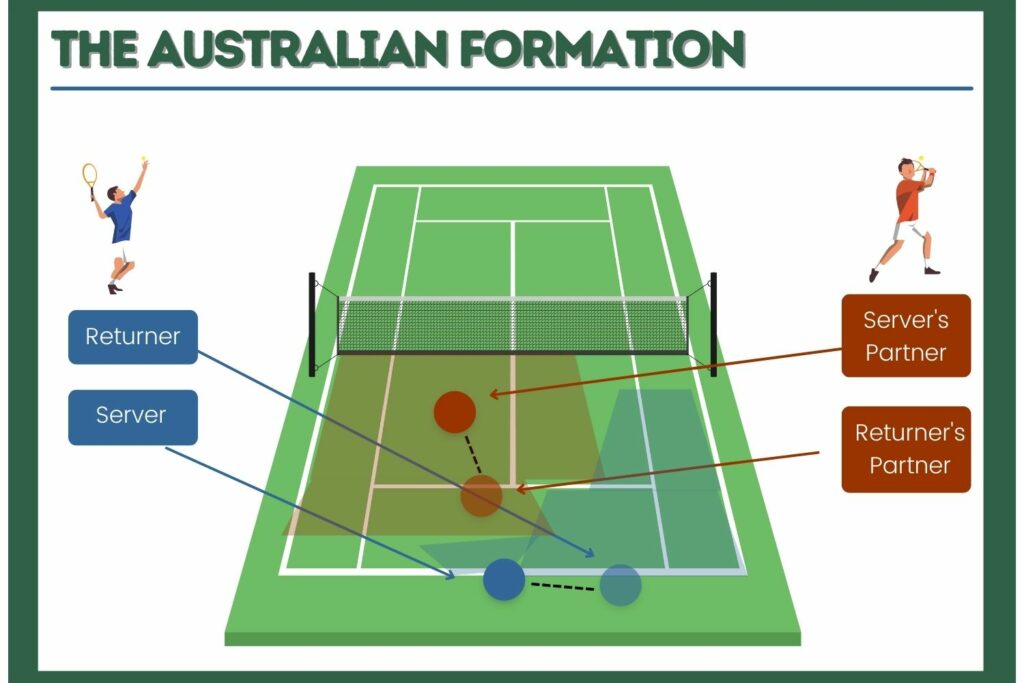
The net player will have the advantage of having more time to cover the cross-court returns. On the downside, this formation will leave half of the court open, putting you at a higher risk of losing the point. You should only do it if both players have great skills; the server is very good in big serves, and the net player does a great job at cross-court hits.
The I-Formation
The I-formation is suitable for intermediate and advanced double players. The net players should stand on the service line, or at least very close to it, while the server should stay close to the baseline’s center.
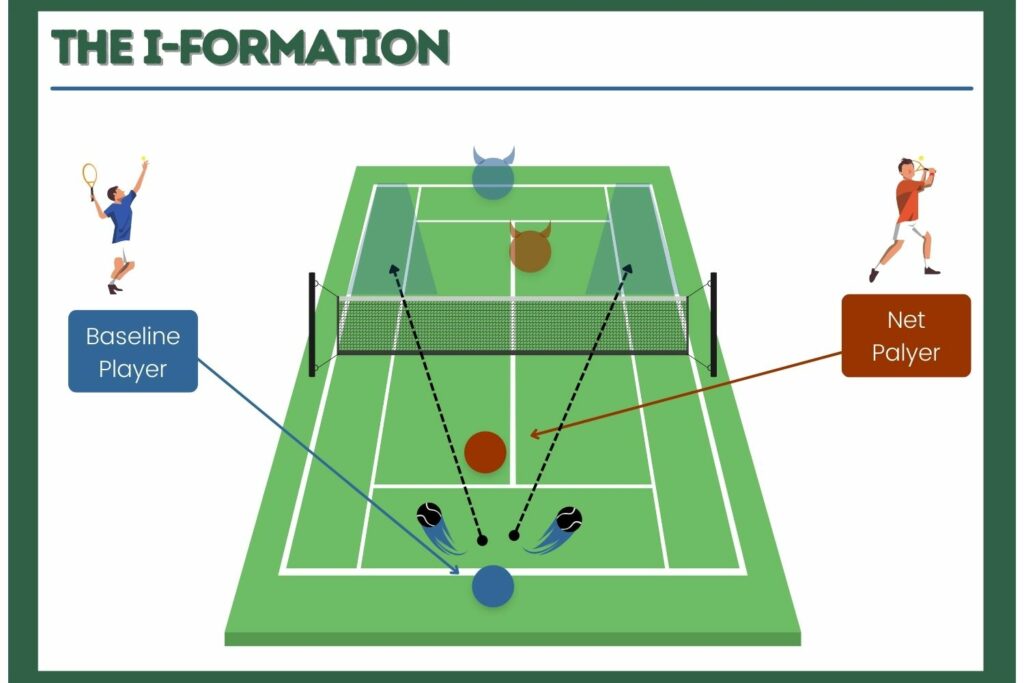
The I-formation is great, especially for the net player when aiming to poach. This allows the players to be more aggressive and confuse the opponent, who will have a harder time predicting your next move.
However, this formation leaves a part of the court open, and you’ll be having a difficult time in case of a return down the line. You should use this if you are really good at crosscourt hits.
The “Two Back” Formation
The “Two Back” formation is exactly what it sounds like; both players position themselves on the back of the court. This is a well-known tactic that players apply when the net person is struggling and can’t keep up with cross-court hits or fast exchanges.
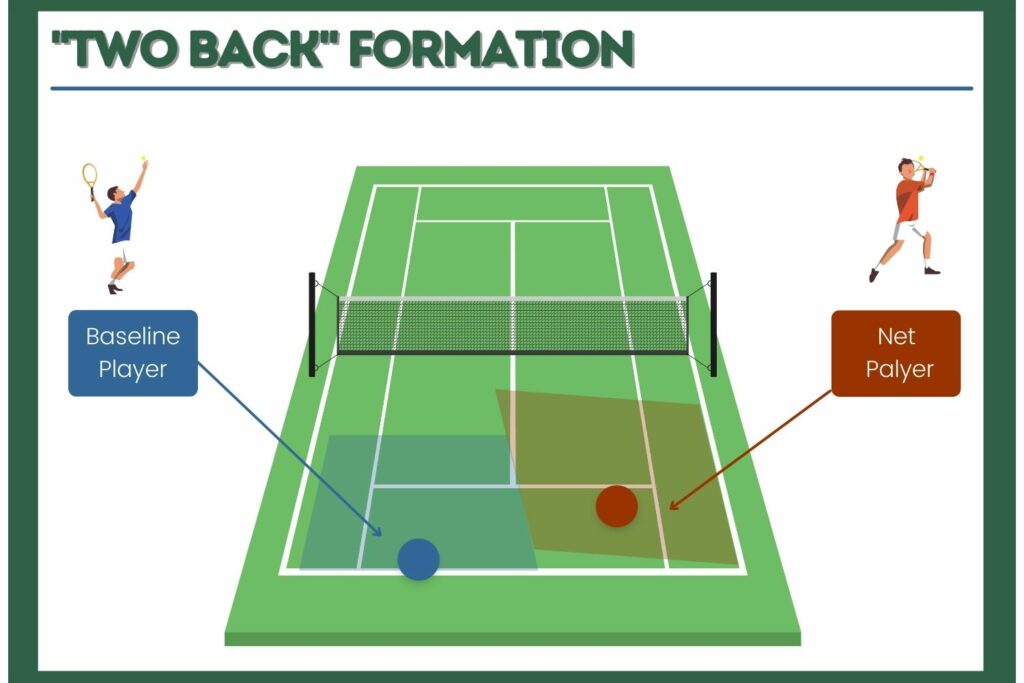
Another case when both players should position themselves in the back is when they are struggling in returns and their opponent is a big server. This formation will give you more time to react and create a better defense wall. However, this also means that you are leaving a good part of the court uncovered, and you have to rely more on the returns.
Doubles Strategy At The Net
Up in the net is where double tennis players will have to spend a lot of time; that’s why having a great net strategy is a necessity. Here are three big lessons that you should keep in mind always:
- Poaching: by forcing an error on your opponent, you’ll be gaining more time to react and expose your opponent’s weakness on the court. This tactic can be done by only the person in the net, who will have to rely on, and hit the ball in a relatively easy volley.
- Pinching: by moving diagonally, on the net’s middle, you’ll be covering the court better, and avoid any rally on cross-court, forcing the opponent to go for more difficult shots.
- Faking: you act as you poach, but you use this time to recover faster by double allies. This will force them to do a mistake, or at least make the game fairly easier for you.
Doubles Strategy On Serve
When it comes to serving in double tennis games, it’s important to communicate with your partner, to set the net player up for a volley. A good serve strategy is mandatory as well, so here is what you should do;
- Go for your opponent’s weakness: usually, the backhand slices or the forehand returns. By applying our basic double tennis tip, you’ll be able to identify your opponent’s weakness faster and act accordingly to put yourself at an advantage.
- Lead with your strength: it will boost your confidence, help you perform better, and prevent your opponent from identifying your weaknesses. Whatever your strong point in the game is, a big, effective serve, poaching, lobs, cross-court hits, etc., use it as much as possible to put your opponent under much more pressure.
Doubles Strategy On Return
You’ll spend almost half of the game in serves and, as a result, in the returns too. The opponent net player will put away effortlessly a weak return, making you struggle and even lose some precious points. That’s why a good return strategy may make or break the game.
Make sure not to make the common mistake of going over the top for returns, wasting time and energy. Instead, you should focus on taking the ball away from the net player until you close the point. For double players, setting your partner up for volleys should be the main focus.
Aiming for the middle strap is one of the best doubles tennis strategies because it’s the lowest net part, meaning a higher margin of error. It will also help you keep the ball low and aim for your opponent’s feet while simultaneously taking away shooting angles, making hitting a volley mission impossible.
FAQs
Doubles tennis strategies are a must-know to defeat your opponents. Players should be up to date on how to beat a lobber, how to win with a weak partner, and where to position themself for a precise return.
Q: How do you beat a Lobber in doubles tennis?
When playing against a Lobber in doubles tennis, it’s important to remember not to stand too close to the net. This will allow you to have more time to react and get back in position if they hit a lob. In addition, try to anticipate where the Lobber is going to hit the ball and move into that area ahead of time. This will put you in a better position to return their lob shot.
Q: How do you beat pushers in doubles?
Pushers in doubles can be beaten by applying pressure to their serve. This means going for a big return that will force them to make a mistake. Additionally, try to stay at the baseline and make them hit more shots. This will tire them out and make it easier for you to win the rally.
Q: How do you win doubles tennis with a weak partner?
When your partner is weak, you’ll want to play on the ad side of the tennis court as much as possible. This will give your weaker partner a chance to play more with their forehand, which is typically their stronger side.
Q: How can I be more aggressive at the net in doubles?
In doubles, it’s important to be aggressive at the net in order to put pressure on your opponents. One way to do this is by taking the ball early before your opponents have a chance to set up their defense. You can also try to anticipate where your opponents will hit the ball and get into position to volley it.
If you can keep your opponents guessing, they’ll be more likely to make mistakes, which will give you an advantage. Be sure to stay calm and focused on the court, and take your time when making decisions – rushing will only lead to mistakes. With a little practice, you’ll be able to become more aggressive at the net and win more points!
